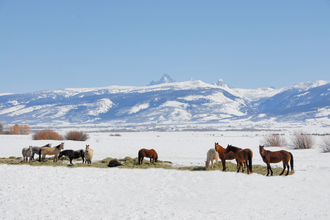Proper feeding, watering, housing, and care of horses during cold weather can make the difference between a healthy horse and one that suffers from illness and discomfort.

Cold weather protection for horses
When environmental temperatures, including wind chill, drop below 45 degrees F (the critical temperature), significant amounts of energy are used by the horse to maintain its internal body heat.
During cold weather, your horse requires additional energy to maintain its internal body temperature and keep warm. The exact amount of energy depends on the severity and extent of the cold period. In the many areas, weather is variable and horses typically experience a dramatic drop in temperature for one to three days, followed by a return to moderate, normal temperatures.
When environmental temperatures, including wind chill, drop below 45 degrees F (the critical temperature), significant amounts of energy are used by the horse to maintain its internal body heat.
The amount of energy required by the horse to meet daily energy needs is measured as digestible energy (DE) in calories. The critical temperature can be used to estimate increased energy needs which the horse must obtain from its diet.
For each 1 degree F decrease below the critical temperature, the horse requires a 1 percent increase in digestible energy to maintain a consistent body temperature.
Wind chill, moisture and coat thickness will affect the critical temperature. The horse’s thick winter coat has an insulating effect against cold and wind. If the coat becomes wet, the critical temperature will increase by 10 to 15 degree F.
Ten tips for effective cold-weather management for your horse
- Monitor weather forecasts to determine cold periods in advance
- Increase the dry-matter content of the diet 24 hours prior to forecasted cold conditions
- Strive to keep your horse in good body condition prior to winter months
- Determine your horse’s critical temperature and adjust DE intake accordingly
- Increase hay intake to horses in good body condition and “easy keepers”
- Increase forage and concentrate intake for horses in poor condition and “hard keepers”
- Supplement fat to increase the energy density of concentrates
- Feed the same concentrate as a moist mash during cold periods
- If horse's coat becomes wet, rub horse down to dry hair coat
- Offer at least 10 gallons of warmed water daily
